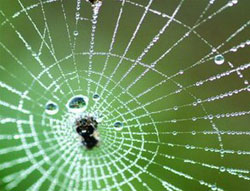Spider silk - Biomaterial of the future
 People talk a lot about the miraculous properties of silk, especially spider silk because the structure of silk is stronger than steel and they can be stretched 40% more than the basic length before breaking.
People talk a lot about the miraculous properties of silk, especially spider silk because the structure of silk is stronger than steel and they can be stretched 40% more than the basic length before breaking.
Spider silk is also 'transformed' in many different forms depending on the interweaving in a spider web with different circumference and different tension.
However, there is an obstacle to the application of the above characteristics that they 'serve' the task of giving, not human. Therefore, studying and applying the next technique is essential for humans to convert spider silk into useful material. This is also the way Dr David Kaplan and colleagues at Tufts University are working hard.
Previous studies have identified DNA sequences in spider silk protein genes that produce different properties of end products. The most important problem of these characteristics is hydrophilia (a tendency to interact with water), hydrophobia (a tendency to stay away from water) and the ability to automatically connect to other proteins, thus creating a large shape. more and more complex construction.
Mr. Kaplan has studied the possibility of extending silk properties beyond those inherent in nature. Later, he discovered and described them in the specialized journal Biomacromolecule.
Through changing the order and amount of hydrophilic, hydrophobic and DNA structural fragments, and then adding the bacteria to transfer the artificial genes created into proteins, he and his colleagues transformed into more than 20 new forms of silk, opening a new page in the history of biofuel development.
- Found a way to transform genes to create spider silk like Spider Man
- Discover the mystery of spider silk
- Producing artificial spider silk lighter than cotton, more durable than steel
- Spider-Man's weapons are not logical about science
- The US military's armor will probably use ten times more kevlar than the spider silk
- Spider silk can transmit sound waves very well
- Video: How to clean up the silk inside a spider?
- See the silk spider, you will have to recognize this is a great architect of the animal world
- Detection of spider silk formation mechanism
- Lightweight fabric from artificial spider silk
- The world's rarest silk weaves from the silk of millions of spiders
- New research: using spider silk will help treat fractures effectively
 Why do potatoes have eyes?
Why do potatoes have eyes? 'Tragedy' the world's largest carnivorous life: Death becomes ... public toilet
'Tragedy' the world's largest carnivorous life: Death becomes ... public toilet Tomatoes were once considered 'poisonous' for 200 years
Tomatoes were once considered 'poisonous' for 200 years Detecting microscopic parasites on human face
Detecting microscopic parasites on human face Darwin's bark spider spins silk to 'build a bridge' 25m long
Darwin's bark spider spins silk to 'build a bridge' 25m long  What is smart clothing technology and how does it work?
What is smart clothing technology and how does it work?  This is the first time Vietnam has a silk machine from a lotus tree
This is the first time Vietnam has a silk machine from a lotus tree  Successfully manufactured biodegradable plastic materials
Successfully manufactured biodegradable plastic materials  Revealing the secret of spiders creating the world's most durable silk thread
Revealing the secret of spiders creating the world's most durable silk thread  How was silk invented?
How was silk invented? 